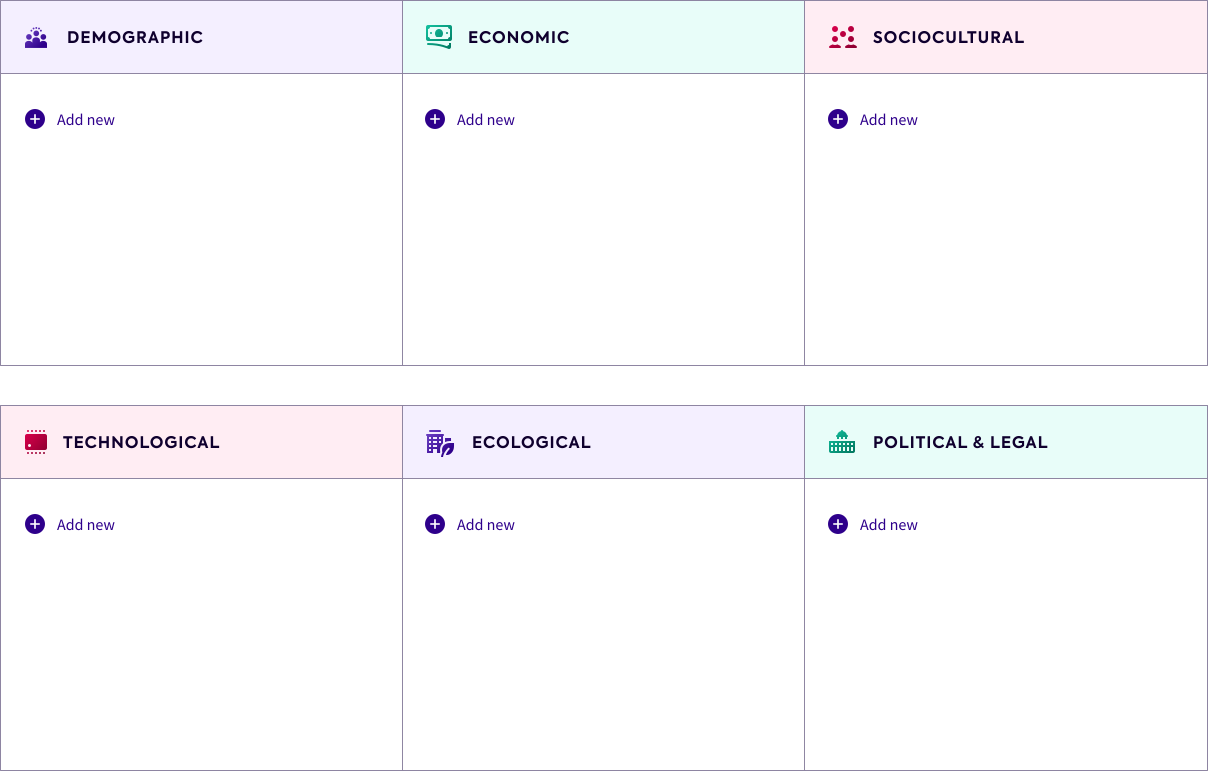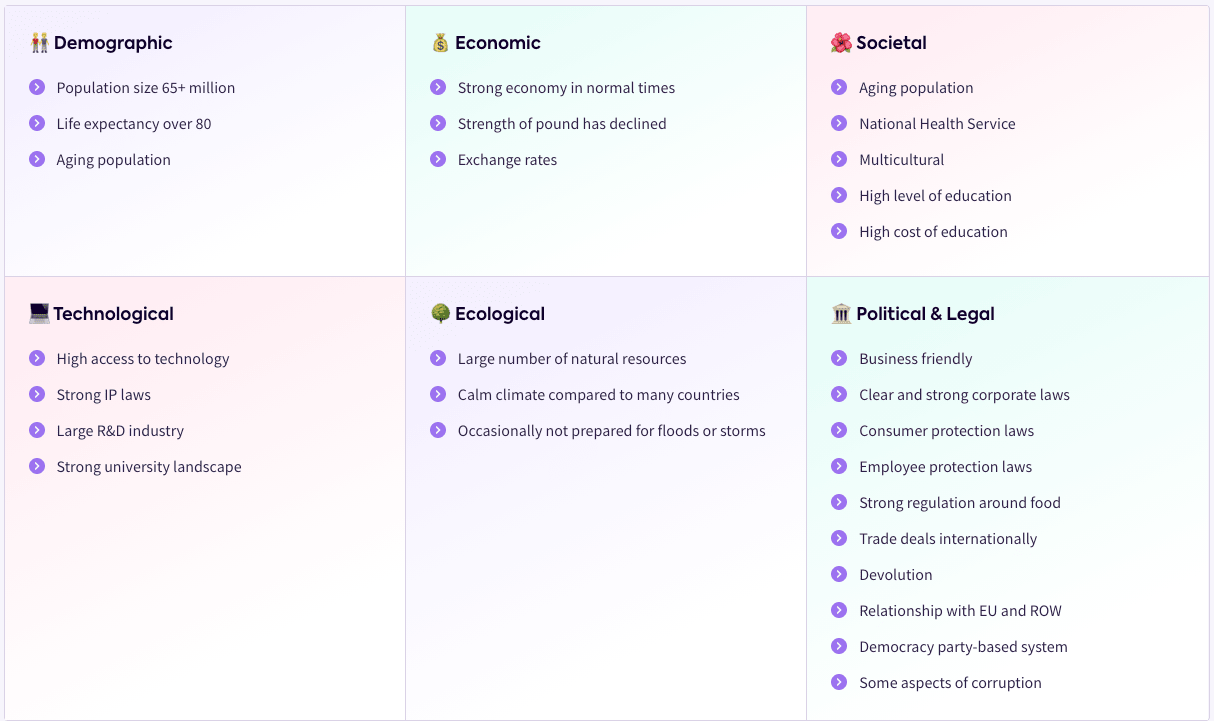What is a DESTEP Analysis?
A DESTEP Analysis is a framework used to understand the external environmental factors and the issues that may impact you. DESTEP stands for Demographic, Economic, Sociocultural, Technological, Ecological and Political/Legal. These are the six categories you use to list factors that could impact your business. It’s commonly presented as a six pillar structure or a 2×3 matrix, and can be applied to any business in any industry. As you’ve maybe noticed, it’s very similar to PESTLE but with a more refined focus on Demographics.
The structure of a DESTEP allows you to easily view all of the key external factors influencing your business in one diagram.
Demographics covers the traits and characteristics of the population. Factors such as age range, geographies, education levels, gender, and family structures.
Economic considerations include economy stability, currency strength, recession, exchange rates, disposable income, inflation, and any factor that relates to the financial conditions of the key market factors. These are often outside of your control, but you can plan accordingly.
Sociocultural is the topic for any social or cultural factor. Topics such as beliefs, risk tolerance, values, or behavioural trends are covered in this area. Note that, unlike in PESTLE, no demographic factors feature in this section.
Technological considerations are the factors around innovation, usage, knowledge and future. Include cybersecurity, analytics, mobile usage, IoT, AR, VR, Blockchain, and other technologies that may change the way you or your customers do business.
Ecological covers everything in the environmental. It’s a larger topic in recent years, including areas around climate change, carbon footprint, recycling and waste management.
Political/legal is the final part of DESTEP and covers everything that relates to regulation, laws and policies. This section greatly impacts every company regardless of how large or small. For example, tax relief for R&D may help a start-up, whereas the UK sugar tax has impacted Coca-Cola.
In short, A DESTEP analysis is a simple framework that can help you to analyse those external factors which are beyond your control and will affect your business.
How is DESTEP different to PESTLE?
They’re very similar and you’re unlikely to use both at the same time. DESTEP gives more focus to the Demographic, which in PESTLE is covered in Social. Conversely, DESTEP combines Political and Legal, which are separate in PESTLE. DESTEP also has no geographic version, whereas PESTLE has a LoNGPESTLE variation.
What are the advantages of DESTEP?
DESTEP Analysis has a number of advantages:
- It’s easy to use and understand
- There’s a simple process to follow
- It works as a group or individual
- It stimulates discussion on the outside world
• It has an emphasis on considering demographics
• It can provide a detailed but digestible view on the external factors
What are some of the limitations of DESTEP?
DESTEP has a few limitations:
- It combines Political and Legal which reduces analysis for some companies
- It is easy to be too broad or not factual enough
- It has high level detail on a lot of subjects, rather than in-depth analysis
- It doesn’t contain a way to weight the importance of the elements of the DESTEP
How do you make the most out of DESTEP?
DESTEP is a really helpful framework. When you complete it fully, you can find opportunities and threats that often can be missed externally. You don’t need to take action on them, sometimes just knowing they exist can be enough to influence your subsequent decisions.
To make sure you get the most out of DESTEP ensure you:
- Prepare for the session well by looking at the topics in advance
- Have a wide range of participants feeding into the PESTLE, ideally you’re looking for a range of backgrounds and experience
What prework should be done before a DESTEP?
In advance of developing your DESTEP it’s good to have the following:
- Trends currently impacting your customers
- Geographic location of your customers and your operations
- Latest news on your industry from a service like Google News
- List of your key suppliers and their industries
- Examples of recent sales wins and examples of customers leaving
- It can be helpful to have one person research each section of DESTEP in advance to bring initial ideas
- Any industry analysis toolkits such as Crunchbase to establish activity or competitor movements
If in a group, these can be shared via an email or a tool (like Lucidity!) beforehand or presented on the day.
What’s the best medium for DESTEP?
You’ll get the best DESTEP Analysis from working in a cross-disciplined team. The mix of different people, backgrounds, roles and experiences will result in the most detailed and helpful analysis on your external environment and ensure you capture all the factors that will impact your strategy and business.
What is an example DESTEP?
Many example DESTEPs can be found in the Lucidity strategy software such as:
How often is DESTEP updated?
Your external environment is changing all the time, so it’s best to do a full review your DESTEP Analysis on at least an annual basis. Running smaller reviews every few months will keep it useful and relevant.
The other benefit to an updated DESTEP is it remains a useful onboarding tool. New team members joining your company will be able to quickly see the external factors impacting the business.
What are the alternatives to DESTEP?
As a framework DESTEP is focused on the external environment, so good alternative tools would be PESTLE and LoNGPESTLE.
How do I complete a DESTEP Analysis?
We’ve created a hand video guide to DESTEP Analysis that covers that very topic! Head over to take a watch… 👍
What frameworks work well with DESTEP?
A DESTEP Analysis will complement your SWOT Analysis and your Five Forces Analysis.
















